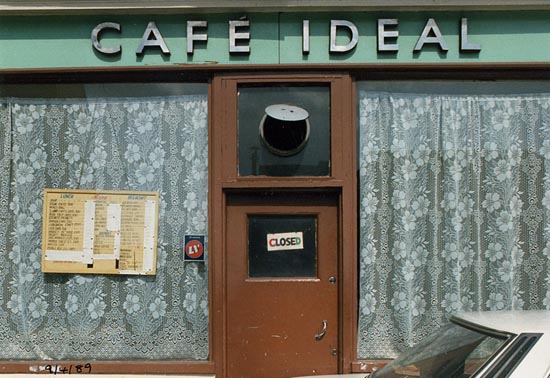Of course most photographers have probably had their pictures used without permission at times. I’ve opened newspapers and been surprised to find my pictures, found them on web sites where I know I’ve not given permission. Quite often I’ve had e-mails from people who’ve spotted my work and have written to tell me in case I wasn’t aware.

Images from Café Ideal, Cool Blondes, and Paradise are among those of mine
which have been used without permission
Of course sometimes the uses have been legitimate – and I’ve had at least one slightly embarrassing incident where I’ve e-mailed to a newspaper about unauthorised use only to find later that one of the agencies I use had sold them the image but hadn’t let on to me. Perhaps not my fault, but still something I’d rather hadn’t happened.
One one or two occasions I’ve profited from such abuse, and after making a complaint have been paid at the top end of the scale for the unauthorised usage – UK law allows only reasonable compensation, unlike in the US, where if images have been registered with the US Copyright Office you can claim punitive damages. But mostly the cases I’ve discovered have been of use by people or groups with no commercial interest or money, mainly supporting causes that I also support, and I’ve often been content with an apology and – if not already present – proper attribution and a link to my site, or sometimes a purely nominal payment (though probably not as nominal as some that I get through on-line agencies.) Sometimes I’ve been content merely to get the images removed from web sites, and have successfully used DMCA takedown notices.
There is a truly excellent article Help! Ive Been Infringed! by Carolyn E Wright on her Photo Attorney blog which I’ve recommended before and has helped me, and has a link to other pages of her sage advice, including a step-by-step on using the DMCA. And all photographers, especially those in the UK will find David Hoffman’s Copyright in the 21st century on EPUK an interesting read.
Something which appears to be on the increase is the use on photographers own web sites of pictures taken by other photographers as if they had taken them. On the EPUK web site earlier this year, Si Barber wrote a piece ‘Repeat Offender?‘ about a “British professional photographer … accused by photographers from around the world of using their copyright images as his own for a second time!
This is a practice that does seem to be rather too common, particularly with wedding photographers, as you can see from the newly founded Photo Stealers Tumblr blog, at the top of which is a link, Know a Thief?, inviting you to send in their details. (Something I heard about from a PetaPixel post, where one of the comments comes from a useful looking web site, Photography & copyright abuse, also in the business of naming and shaming copyright offenders.)
What started me thinking about this was something quite different, a post on the Alamy Stock Photography blog, Image Licensing: Time for a Change?, which introduced their “white paper” of the same title, a rather disappointing report of a “a round table discussion in London with a wide spectrum of key decision makers on the subject of stock image pricing and licensing models. These included picture buyers, photographers, journalists and commentators as well as stock image agencies.”
As I write there are around 70 comments on the article, many simply slagging off Alamy and in particular the poor visual quality of many of the images it has on-line, with a quality control system that limits itself almost entirely to technical details and virtually no editorial control.
One contribution that stands out head and shoulders above the rest is No. 27 by Pete Jenkins – as might be expected from someone who, together with Andrew Wiard serves as the Photographers representative on the NUJ’s National Executive Committee.